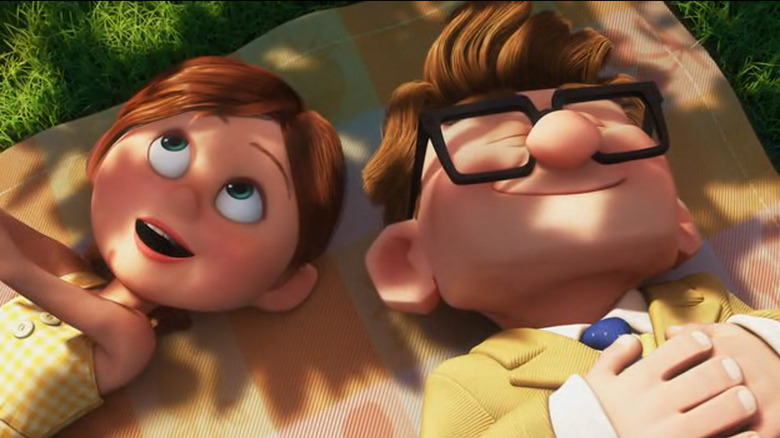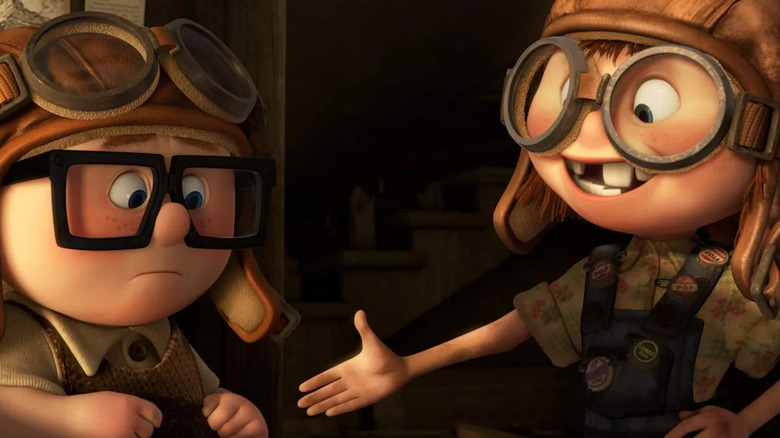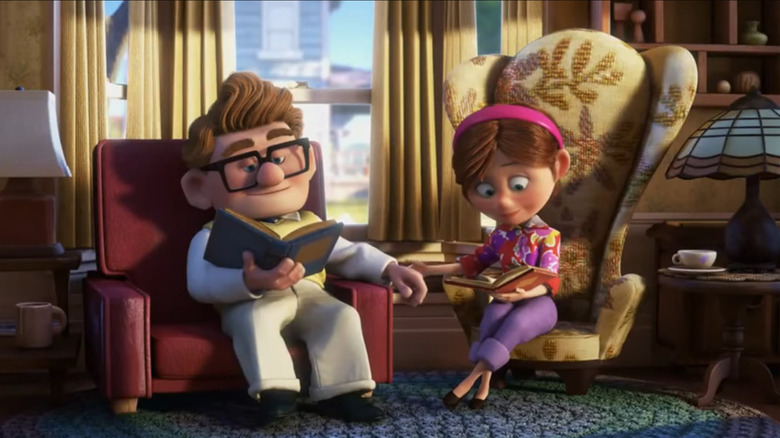30 Minutes Had To Be Cut From The Opening Sequence Of Up
Pixar has been pulling at the heartstrings of moviegoers around the world since it was founded. From their early short films to their feature work, the studio always infuses their projects with deep emotions alongside stunning animation. A toy discovering he is not a real person. A monster saying goodbye to a child. The loneliest robot on the planet. You know the greatest hits. But nothing could prepare fans for the emotional damage that is "Up."
For much of its running time, "Up" is a classic old-school adventure set in a lost land based on the Angel Falls of Venezuela, and powered by the fantastic dynamic between a grumpy old man and an enthusiastic kid. And of course, there are some really cool and dynamic aerial fight scenes.
But of course, the one sequence that continues to resonate so many years after the film's release is its opening, often referred to as "Married Life" after composer Michael Giacchino's title for the accompanying music. A brisk sequence with no dialogue, it's super-effective in telling you everything you need to know about the main character, Carl Fredricksen, his late wife Ellie, and the devastating death that motivates Carl to literally make his house float away. Though the final scene is under five minutes long, it went through many changes over time — including a much longer runtime.
'I kept pushing to see how much we could take out'
Speaking to The Ringer, director Peter Docter explained that they "overwrote like crazy" for this sequence, and at one point the animators had "30 to 40 minutes of material that we slowly whittled down." Now, the scene was never going to be 30 minutes long, as that is a third of the total runtime of the film, but what they chose to cut and what they chose to keep speaks volumes about how the sequence works in its final form.
For example, the montage originally had dialogue for the characters, but storyboard artist Ronnie del Carmen suggested to let Giacchino's score do the talking. Docter agreed. "I kept pushing to see how much we could take out, and discovered that it seemed like the less we had the more emotional it felt," Docter said, crediting his love for silent films for his knack for minimalism. "No dialogue, no sound effects — just music and visuals. It's pretty tight. Every shot is a setup for elements we use later in the film."
One element that almost didn't make it to the final scene was Ellie's miscarriage. In the film, Ellie and Carl try to have a baby, and everything seems fine until we see them at the doctor and it becomes clear that they can't have children. "There was a time that a few people at Pixar felt that the miscarriage went too far, so we tried editing it out," said Docter. "Without it, that montage was not as emotional, of course — but interestingly the rest of the film suffered without it and we didn't care as much through the whole movie. So of course we cut it back in."
Emotional damage
There was another noteworthy element trimmed from this sequence. As Docter told Rotten Tomatoes, the very first draft of the film had Carl and Ellie's first meeting involve a fight over a bird Carl wanted to catch. This causes a back and forth bit where the two jokingly punch each other everywhere from a Christmas pageant to the middle of taking out the trash. But when test audiences responded poorly, these moments were cut:
"As it turned out that sequence really reduced down to about four-and-a-half minutes. It's really not too long but it also becomes the emotional bedrock on which the rest of the film relies to move forward."
He's not wrong. The joke punches would have been cute, but just like having spoken dialogue, it would have taken away from the emotional damage that makes this scene so special. We get a whole lifetime worth of experiences and memories in just under five minutes, expertly paced and accompanied by Giacchino's score. The first half of the montage is devoted to the joy Ellie brings to Carl's life, how much she take the initiative, and how much she brings out the adventurer in him.
After Ellie's miscarriage, the music and the tone changes to something much more somber, and the tempo of the animation slows down as Ellie's joy and energy starts draining. It is this montage of joy and loss, a recap of the heartbreaks Carl has endured, that sell us on the idea that this man would decide to literally make his house float away with balloons rather than face the darkness alone. It's why the movie was so celebrated upon release, and it's why we continue to remember it years later. And why we cry at the mere mention of it.


